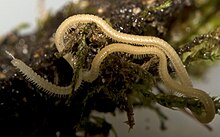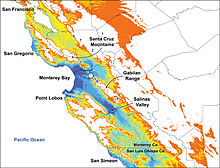Illacme plenipes
| Illacme plenipes | |
|---|---|

| |
| A female I. plenipes with 618 legs | |
| Scientific classification | |
| Domain: | Eukaryota |
| Kingdom: | Animalia |
| Phylum: | Arthropoda |
| Subphylum: | Myriapoda |
| Class: | Diplopoda |
| Order: | Siphonophorida |
| Family: | Siphonorhinidae |
| Genus: | Illacme |
| Species: | I. plenipes
|
| Binomial name | |
| Illacme plenipes | |

| |
| Predicted habitat suitability (maximum in blue) for I. plenipes based on climatic variables | |
Illacme plenipes is a siphonorhinid millipede found in the central region of the U.S. state of California. It has up to 750 legs. One of three known species in the genus Illacme, it was first seen in 1926, but was not rediscovered until 2005, almost 80 years after its discovery, by Paul Marek, then a Ph.D. student at East Carolina University.[1]
Description[edit]
On average, I. plenipes have over 600 legs, twice the average for millipede species, with one recorded specimen having 750 legs.[2] It had the most legs of any species known until Eumillipes persephone was described in 2021, which had 1306 legs.[3][4] It is relatively small-bodied among millipedes. Females grow to just over 3 cm; males are slightly smaller and have fewer legs.[2]
Taxonomic history[edit]
The species was first discovered in San Benito County, part of the California Floristic Province, in 1926 by federal scientist Orator Cook and formally described by Cook and Harold F. Loomis in 1928.[5] Cook and Loomis described the species without illustrations, and in 1996 Rowland Shelley of the North Carolina Museum of Natural Sciences re-examined specimens and redescribed the species.[6] Marek and colleagues produced a more detailed description of the morphology of I. plenipes in 2012 and provided refined illustrations based on scanning electron micrography.[2]
Classification[edit]
Illacme is a member of the order Siphonophorida and family Siphonorhinidae. A second species of the genus, Illacme tobini, was described in 2016.[7] Based on a phylogenomic analysis of millipedes in the subterclass Colobognatha, the closest relative of Illacme is Nematozonium of South Africa which shares a long, narrow body shape and characteristics including gonopods.[8]
References[edit]
- ^ Paul E. Marek and Jason E. Bond (2006). "Biodiversity hotspots: rediscovery of the world's leggiest animal". Nature. 441 (7094): 707. Bibcode:2006Natur.441..707M. doi:10.1038/441707a. PMID 16760967.
- ^ a b c Marek, P.; Shear, W.; Bond, J. (2012). "A redescription of the leggiest animal, the millipede Illacme plenipes, with notes on its natural history and biogeography (Diplopoda, Siphonophorida, Siphonorhinidae)". ZooKeys (241): 77–112. Bibcode:2012ZooK..241...77M. doi:10.3897/zookeys.241.3831. PMC 3559107. PMID 23372415.
- ^ Marek, Paul E.; Buzatto, Bruno A.; Shear, William A.; Means, Jackson C.; Black, Dennis G.; Harvey, Mark S.; Rodriguez, Juanita (2021). "The first true millipede—1306 legs long". Scientific Reports. 11 (1): 23126. Bibcode:2021NatSR..1123126M. doi:10.1038/s41598-021-02447-0. ISSN 2045-2322. PMC 8677783. PMID 34916527.
- ^ "We have a new world record holder. Introducing the first millipede with more than 1,000 legs - ABC News". amp.abc.net.au. Retrieved 2021-12-18.
- ^ O. F. Cook & H. F. Loomis (1928). "Millipedes of the order Colobognatha, with descriptions of six new genera and type species, from Arizona and California". Proceedings of the United States National Museum. 72 (18): 1–26, f. 1–6, pls. 1–2. doi:10.5479/si.00963801.72-2714.1.
- ^ Shelley, Rowland M. (1996). "The milliped order Siphonophorida in the United States and northern Mexico" (PDF). Myriapodologica. 4 (4): 21–33. Archived from the original (PDF) on 2014-07-31. Retrieved 2019-03-13.
- ^ Marek, Paul E.; Krejca, Jean K.; Shear, William A. (2016). "A new species of Illacme Cook & Loomis, 1928 from Sequoia National Park, California, with a world catalog of the Siphonorhinidae (Diplopoda, Siphonophorida)". ZooKeys (626): 1–43. Bibcode:2016ZooK..626....1M. doi:10.3897/zookeys.626.9681. PMC 5096369. PMID 27833431.
- ^ Marek, Paul E.; Buzatto, Bruno A.; Shear, William A.; Means, Jackson C.; Black, Dennis G.; Harvey, Mark S.; Rodriguez, Juanita (2021). "The first true millipede—1306 legs long". Scientific Reports. 11 (1): 23126. Bibcode:2021NatSR..1123126M. doi:10.1038/s41598-021-02447-0. ISSN 2045-2322. PMC 8677783. PMID 34916527.
External links[edit]
- National Public Radio News article on Illacme plenipes
- Voice of America Our World broadcast
- Alicia Chang (August 8, 2006). "Rare millipede found in California". Discovery Channel. Archived from the original on February 7, 2008.
- BBC article on Illacme plenipes with film
